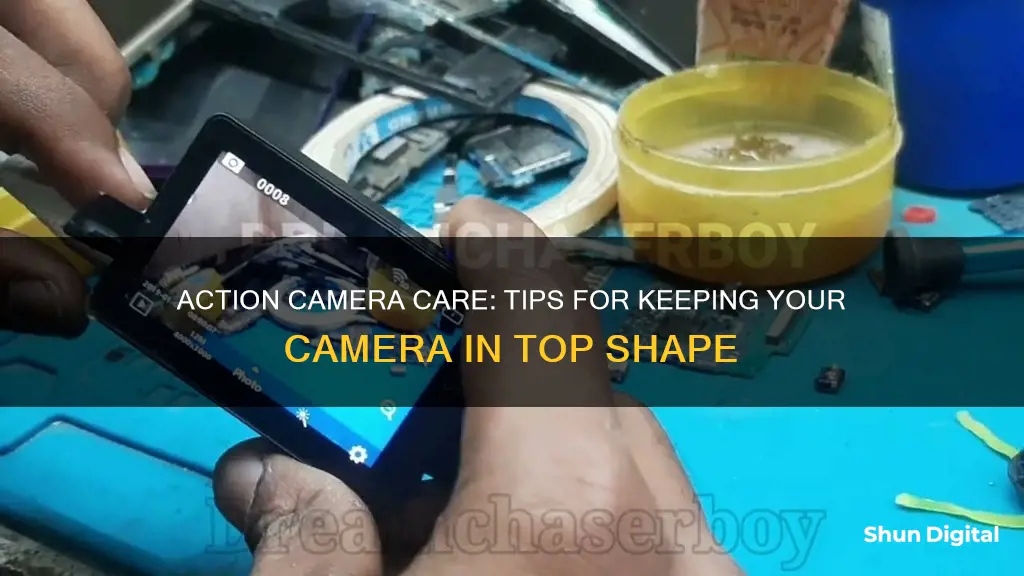
Action cameras are small, lightweight, and highly portable, making them ideal for capturing action and adventure. Their rugged design and waterproof capabilities enable users to record thrilling experiences in stunning 4K or high-definition quality. To ensure the longevity and optimal performance of your action camera, proper care and maintenance are crucial. This includes keeping the camera clean, using a soft cloth for the body and a lens cleaning solution for the lens, and protecting it from extreme temperatures, water, dust, and impacts. Regularly updating the firmware is essential, as well as handling memory cards with care and storing the camera properly when not in use. With the right care, your action camera will capture your adventures for years to come.
What You'll Learn
- Keep it clean: wipe the body with a soft cloth and gently clean the lens with a lens pen or solution
- Handle memory cards with care: always turn off the camera before removing a card and use the designated ejection method
- Protect from extreme temperatures: don't leave in direct sunlight or freezing conditions without adequate protection
- Battery care: store your camera with the battery removed in a cool, dry place
- Safe storage: invest in a padded carrying case to prevent scratches and impacts

Keep it clean: wipe the body with a soft cloth and gently clean the lens with a lens pen or solution
Keeping your action camera clean is essential to maintaining its performance and image quality. Here are some detailed instructions on how to keep your action camera's body and lens clean:
Wiping the Body
- Use a soft cloth: Opt for a microfiber cloth or a similar soft material to gently wipe down the camera's body. This will remove any dust, dirt, or smudges that may have accumulated. Ensure the cloth is clean and free of debris before wiping.
- Be gentle: Avoid applying excessive pressure when wiping the camera body. This will help prevent scratches or damage to the camera's surface.
- Pay attention to buttons and crevices: Use a compressed air blower to remove dust and debris from buttons, ports, and other hard-to-reach areas. Alternatively, a soft brush can help loosen and remove dirt from these areas.
Cleaning the Lens
- Use a lens pen or cleaning solution: A lens pen is a handy tool with a brush on one end and a special cleaning tip on the other. Gently clean the lens surface with the brush or the cleaning tip, using circular motions. Alternatively, apply a small amount of lens cleaning solution to a microfiber cloth and gently wipe the lens. Avoid pressing too hard to prevent scratches and smudges.
- Be gentle: The lens is delicate, so handle it with care. Avoid using your fingers or a rough cloth, as they can scratch the lens and cause permanent damage.
- Remove loose particles first: Before applying any cleaning solution, use a lens brush or a microfiber cloth to gently remove any loose dust, dirt, or fingerprints from the lens surface.
- Keep it dry: After cleaning the lens, use a clean, dry microfiber cloth to gently wipe away any remaining moisture and ensure the lens is completely dry.
Audio Surveillance in South Carolina: What's the Law?
You may want to see also

Handle memory cards with care: always turn off the camera before removing a card and use the designated ejection method
Memory cards are essential for storing and transferring your action camera footage, so it's important to handle them with care to avoid data loss or damage to the camera. Here are some detailed instructions on how to handle memory cards safely:
Always turn off your action camera before removing the memory card. This is crucial to avoid file corruption and ensure data integrity. By powering down the camera first, you minimize the risk of interrupting any ongoing data writing processes. It's a simple step, but it goes a long way toward protecting your files.
Use the designated ejection method provided by your camera manufacturer. Avoid forcefully removing the card. Action cameras typically have a specific button or mechanism for safely ejecting the memory card. By using this designated method, you prevent damage to the card or the card slot. Forceful removal can cause physical damage to the card or the camera's internal components, leading to data loss or hardware malfunction.
When inserting a new memory card, ensure it is compatible with your camera model. Action cameras usually use microSD cards, but it's important to verify the recommended specifications from the manufacturer. Check the user manual or the manufacturer's website to ensure you're using a compatible card. Using incompatible cards can lead to performance issues and data loss.
Format the memory card within the camera settings for optimal performance. After inserting a new memory card, take a moment to format it according to your camera's settings. This helps the card function optimally with your specific camera model and can improve its overall performance and compatibility.
Handle the memory card gently to avoid physical damage. When inserting or removing the card, be careful not to bend or break it. Memory cards are delicate, and physical damage can render them unusable, leading to potential data loss.
Keep your memory cards clean and dry. If your memory card comes into contact with dirt, dust, or water, clean it properly and allow it to dry completely before use. This helps prevent any liquid or debris from interfering with the card's electrical contacts, ensuring smooth data transfer and reducing the risk of corruption.
By following these instructions, you can effectively minimize the risk of data loss and hardware damage when handling memory cards for your action camera.
Charging Your X10 Camera: A Step-by-Step Guide
You may want to see also

Protect from extreme temperatures: don't leave in direct sunlight or freezing conditions without adequate protection
Extreme temperatures can cause your action camera to malfunction or suffer permanent damage. To protect your camera from extreme heat or direct sunlight:
- Avoid leaving your camera in direct sunlight for extended periods, as the internal components can overheat and become damaged.
- Keep your camera in a gear bag when not in use, especially if stored in a hot car. A cooler (without ice) and a white towel draped over it can also help to protect your camera from overheating.
- Use a white towel or reflective cloth to cover your camera when shooting in the sun. This will help to deflect the sun's rays and keep your camera cool.
- Turn down power usage by disabling features such as live view and constant automatic photo review.
- Open the battery door to help dissipate heat, especially when shooting videos or time-lapses.
To protect your camera from freezing temperatures:
- Do not expose your camera to freezing temperatures without adequate protection. Use appropriate insulation or protective accessories, such as a camera bag, to shield your camera.
- Keep your camera warm by storing it in a pocket or insulated bag close to your body.
- If your camera does get wet inside due to condensation, remove the lens and affected pieces, and place them in a warm, dry location to evaporate the water.
Mastering Focus Techniques with the BMPCC 4K
You may want to see also

Battery care: store your camera with the battery removed in a cool, dry place
To ensure the longevity of your action camera, proper care of the battery is essential. When your action camera is not in use, remove the battery and store it in a cool, dry place. This will help prevent battery drain and potential damage caused by leaking or bloating.
Storing your camera with the battery removed in a cool, dry place is crucial for several reasons. Firstly, it helps to maintain a moderate temperature and humidity level, which is optimal for battery storage. High humidity can cause corrosion and other damage, while low humidity can dry out the battery and make it brittle. By storing the battery in a controlled environment, you can prevent these issues and prolong its lifespan.
Additionally, removing the battery when not in use helps to prevent battery drain. This is especially important for rechargeable batteries, as partially discharged batteries can degrade over time and may become unusable. By keeping the battery charged and stored separately, you ensure that it retains its full charge and is ready for use when needed.
It's also important to consider the storage environment. Avoid leaving your action camera or battery in direct sunlight or extreme temperatures, as this can cause internal damage. Instead, opt for a well-ventilated storage area that is protected from extreme conditions.
When storing your battery, ensure that it is properly secured and won't roll or fall, which could cause damage or short-circuiting. You can use a dedicated battery storage case or a compartment within your camera bag to keep the battery safe and organized.
By following these battery care tips, you can ensure that your action camera remains powered and ready for your next adventure.
Uninstalling Camera Raw: A Guide for Windows 10 Users
You may want to see also

Safe storage: invest in a padded carrying case to prevent scratches and impacts
Safe storage is essential to prevent scratches and impacts on your action camera. To achieve this, it is recommended to invest in a padded carrying case.
A padded carrying case provides a safe and secure home for your action camera when it is not in use. The padding, often made from high-density foam, acts as a barrier against potential knocks and bumps, absorbing any impact and protecting your camera's body and lens. This is particularly important for action cameras, which are frequently exposed to adventurous and unpredictable environments.
When choosing a carrying case, opt for one with a durable and water-resistant exterior. Nylon is a popular choice for its ability to repel water and withstand rough handling. The case should also have a comfortable handle, making it easy to transport your camera from one thrilling adventure to the next.
In addition to protection, a well-designed carrying case offers perfectly shaped compartments to securely hold your camera and its accessories. This ensures that everything you need is in one place and reduces the risk of losing any essential components. The case's interior should also feature a soft lining, such as flannelette, to provide an extra layer of cushioning and safeguard against accidental drops.
By investing in a padded carrying case, you can have peace of mind knowing that your action camera is protected from scratches and impacts during storage and transportation. This simple yet effective measure will help extend the lifespan of your camera, ensuring it remains in optimal condition to capture your most exciting moments.
Surveillance Cameras: Live or Recorded?
You may want to see also
Frequently asked questions
Use a soft or microfiber cloth to gently wipe the camera body. Clean the lens with a lens cleaning solution or a lens pen.
Use a waterproof case or housing to shield your camera from water, dust, and impacts. Avoid exposing the camera to extreme temperatures, and invest in a padded carrying case for storage and transportation.
Before removing the memory card, turn off your camera to avoid file corruption. Eject the card using the designated method. When inserting a new card, ensure compatibility and format it within the camera settings.
Avoid leaving your camera with a fully discharged battery. Remove the battery when not in use and store it in a cool, dry place. Charge and discharge the battery fully at least once a month to prolong its life.







